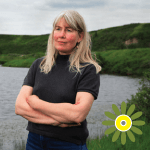
I’ve been following the oil and gas industry’s sulfolane pollution of groundwater for decades.
It’s not an “emerging” or “accidental” pollutant, as described in the researchers’ clip on Youtube. Industry knowingly contaminated groundwater with it, enabled by politicians and industry’s non regulating AER; industry knew it was harming cattle and families, years ago.![]()
Protecting drinking water on prairies from *emerging* pollutant by Canadian Light Source, Apr 10, 2024.
Researchers from the University of Guelph used the CLS to learn more about an emerging pollutant prevalent in groundwater across the Prairies. Sulfolane, which is used to treat sour gas, has recently been linked to fertility issues in cattle and has been found in their milk. …
‘How much time do we have?’: ‘Contamination’ in Prairie groundwater identified by Michael Franklin, April 15, 2024, CTVNews
A compound used to treat sour gas that’s been linked to fertility issues in cattle has been found throughout groundwater in the Prairies, according to a new study.
Scientists at the University of Guelph and University of Saskatchewan have identified “large contaminant plumes” of sulfolane, particularly in Alberta.
Dr. Erica Pensini, associate professor at Guelph’s school of engineering, says researchers are tracking how it is spreading in groundwater, work that could help identify risks to supplies of potable water.
She says the study suggests that naturally-occurring sulfates (salts) react with sulfolane in groundwater and its ability to “mix more thoroughly with water.”
“Sulfolane plumes travel faster with fewer sulfates, so we’re trying to clarify migration in the context of what can we do to tackle this contamination,” said Pensini in a news release.
“We’re also partnering up with hydrogeologists and eco-toxicologists to explore other aspects that we’re not directly exploring in our lab,” said Pensini.
What is sulfolane?
Sulfolane, introduced to the market in 1944 by Shell Oil, is “widely used” to remove hydrogen sulfide – a process better known as ‘sweetening’ – from sour gas at thousands of sites across Alberta(opens in a new tab).
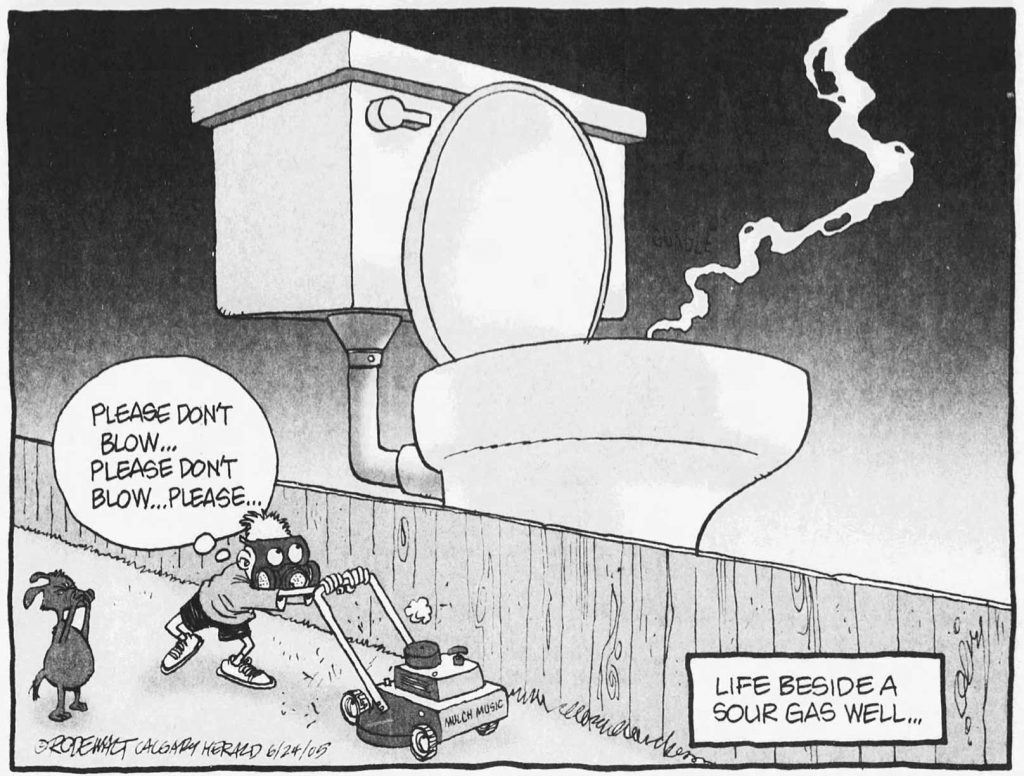
Sulfolane is virtually invisible and doesn’t have a particularly strong smell, so it is nearly undetectable in bodies of water.
“In most cases, you would not notice its presence,” Pensini told CTV News in a statement.
According to a 2008 report by WorleyParsons Komex for Shell Energy Canada, sulfolane was first detected in groundwater in the 1980s and, in 1994, a monitoring program was put in place.
A regional sulfolane monitoring program, which began in 1998, detected sulfolane in off-site groundwater near Shell’s Waterton facility.
By 2007, Shell began actively working to remove sulfolane, building on a pilot project conducted in 2003 and 2004.
Nevertheless, Pensini says the toxicity of the chemical was not fully understood, so it was improperly disposed of.![]() It’s the toxic wild wild west in Canada when it comes to pollution by oil, frac, bitumen and gas. Even known deadly contamination caused by industry, is covered-up by AER and Alberta Environment, with politicians bending over backwards to enable the health harming polluters. If the public or landowners find out, nature is blamed with lots of lies and data fudging, including by research councils and academia, oft leaving landowners with contaminated wells living in life-threatening risk of explosion and or health harms. Even if it was known sulfolane sterilizes kids on contact in the bath or via ingestion, oil and gas companies would still improperly dispose of it, and our politicians and regulators would engage in fraud to enable it. The oil and gas industry has been intentionally dumping their deadly secrets and chemicals and radioactive waste where ever their profit-raping desires it, and their lies and propaganda allow it, including across farmland and pastures even in protected areas like the Suffield National Wildlife Area (most illegal waste dumping there by infamous Encana/Ovintiv, of course), with land agents lying to landowners for decades, telling them the toxic waste is “free fertilizer.”
It’s the toxic wild wild west in Canada when it comes to pollution by oil, frac, bitumen and gas. Even known deadly contamination caused by industry, is covered-up by AER and Alberta Environment, with politicians bending over backwards to enable the health harming polluters. If the public or landowners find out, nature is blamed with lots of lies and data fudging, including by research councils and academia, oft leaving landowners with contaminated wells living in life-threatening risk of explosion and or health harms. Even if it was known sulfolane sterilizes kids on contact in the bath or via ingestion, oil and gas companies would still improperly dispose of it, and our politicians and regulators would engage in fraud to enable it. The oil and gas industry has been intentionally dumping their deadly secrets and chemicals and radioactive waste where ever their profit-raping desires it, and their lies and propaganda allow it, including across farmland and pastures even in protected areas like the Suffield National Wildlife Area (most illegal waste dumping there by infamous Encana/Ovintiv, of course), with land agents lying to landowners for decades, telling them the toxic waste is “free fertilizer.”![]()
“It was therefore released in aquifers by sour gas and sour oil processing plants. There were 5,250 plants in 2007 (in Alberta), based on official sources,” she said.
“Each of these plants could have released different amounts.”
According to the Canadian government, “the toxicological database for sulfolane is limited.”![]() Of course it is, all the better to poison innocent Canadians and their kids, pets and livestock.
Of course it is, all the better to poison innocent Canadians and their kids, pets and livestock.![]()
“Overall, oral exposure to sulfolane in experimental animals was associated with immunological, renal and reproductive and developmental effects,” the government’s website reads(opens in a new tab).
Health Canada says the compound is not likely to accumulate in the human body, but that more than 0.3 milligrams of sulfolane per litre of drinking water is unacceptable.
“Health Canada establishes screening values for contaminants at the request of federal departments, provinces and territories (jurisdictions). These requests are usually made when there is a concern for human health because the presence of a contaminant is suspected or detected in local source water and that contaminant does not have an established limit in drinking water.”
The agency says there are no regulatory limits for sulfolane in other countries, but sulfolane groundwater contamination did prompt authorities in North Pole, Alaska, to include it in the U.S. National Toxicology Program.
![]()
![]()
![]()

2010: Above cover from Alaska Dept Environmental Conservation’s: SULFOLANE TECHNICAL ASSISTANCE AND EVALUATION REPORT FINAL


2014: Above from Canadian water quality guidelines on sulfolane (note, Canada pathetically has no such guidelines of methane and ethane, and heavier hydrocarbons in drinking water even though such gasses can kill by asphyxiation and explosion in our homes, barns, schools, and businesses. Why? Because the oil and gas industry contaminates so much groundwater with explosive levels of gases, and keeps blowing up businesses, people, homes and farms.
![]()
![]()
![]()
Research into whether or not sulfolane poses a risk to human health is still ongoing, Pensini says, but some companies have already raised concerns.![]() Oil and gas companies, largely foreign-owned, and Alberta gov’ts (no matter what stripe), will demand the academics eventually conclude it’s not health harming. Industry and its enablers don’t give a shit about poisoning us and our drinking water, or the air we need to breath, or our lands and foods we eat. I expect CAPP and Danielle Big Oil Dildo Smith and her TBA evangelicals will rule sulfolane is good for us, and blame Trudeau for any contamination in Alberta groundwater, even that which oil and gas companies caused before he was born.
Oil and gas companies, largely foreign-owned, and Alberta gov’ts (no matter what stripe), will demand the academics eventually conclude it’s not health harming. Industry and its enablers don’t give a shit about poisoning us and our drinking water, or the air we need to breath, or our lands and foods we eat. I expect CAPP and Danielle Big Oil Dildo Smith and her TBA evangelicals will rule sulfolane is good for us, and blame Trudeau for any contamination in Alberta groundwater, even that which oil and gas companies caused before he was born.![]()
“For example, Sigma Aldritch, a leading chemical supplier, lists this hazard in their (safety data sheets),” she told CTV News in a statement.
“There is sufficient evidence for its impact on fertility for these to be officially reported.”
Shell working with University of Guelph
Shell Canada says it is aware of Pensini’s research and has been working with the University of Guelph since 2022.
“Shell believes a collaborative and cooperative approach with academia ![]() Translation: We bribe universities to silence pesky researchers and their studies finding our industry is causing health harming pollution. Our endless millions of dollars in donations silence and control academia efficiently and cheaply and
Translation: We bribe universities to silence pesky researchers and their studies finding our industry is causing health harming pollution. Our endless millions of dollars in donations silence and control academia efficiently and cheaply and![]() is key to
is key to improve environmental ![]() keeping our guidelines voluntary and conning the public with voluntary best
keeping our guidelines voluntary and conning the public with voluntary best![]() practices ,” a Shell spokesperson wrote in an email to CTV News.
practices ,” a Shell spokesperson wrote in an email to CTV News.

Shell, which has operated sour gas wells in the Foothills – Jumping Pound, Caroline and Waterton – for 70 years, says it has also worked with the Alberta Energy Regulator (AER) as well as stakeholders and landholders for the past 10 years.
In 2019, Shell sold those sour gas wells to Pieridae, but it is still ![]() not
not![]() responsible for “managing and remediating any impacts at the Waterton and Jumping Pound gas plants.”
responsible for “managing and remediating any impacts at the Waterton and Jumping Pound gas plants.”
Shell Canada did not admit that sulfolane poses a risk to human health, but said its work with the University of Guelph “is an important step in advancing ![]() controlling and silencing
controlling and silencing![]() the science.”
the science.”![]() Translation: We know we’ll be able to keep poisoning drinking water in Canada for decades to come, because populism is on a roll (we finance it, including the violent Fucker Truckers (born from the angry oil industry funded Yellow Vesters) and their new hate and rage farming Axe The Taxers (also financed by oil and gas), we’ll make sure dark money and lies gets anti-truth, anti-science, anti-environment, anti-safe water, anti-safe air, pro-polluter Pierre Picklehead elected with a massive majority, like how we got anti-everything but polluter, liar Danielle Smith and her lying UPC into power with massive majority, led and controlled by the TBA Party of Extreme Hate and Evangelicals.
Translation: We know we’ll be able to keep poisoning drinking water in Canada for decades to come, because populism is on a roll (we finance it, including the violent Fucker Truckers (born from the angry oil industry funded Yellow Vesters) and their new hate and rage farming Axe The Taxers (also financed by oil and gas), we’ll make sure dark money and lies gets anti-truth, anti-science, anti-environment, anti-safe water, anti-safe air, pro-polluter Pierre Picklehead elected with a massive majority, like how we got anti-everything but polluter, liar Danielle Smith and her lying UPC into power with massive majority, led and controlled by the TBA Party of Extreme Hate and Evangelicals.![]()
Rules in place for companies
According to the AER, the body that monitors companies in Alberta’s energy sector, there are 27,562 active sour gas wells in the province, a figure that does not include inactive, abandoned and reclaimed wells.
Many more are scheduled to be drilled, the AER said in a statement to CTV News.![]() Super toxic polluter Alberta, where the corrupt self regulator of polluters keeps enabling more and more deadly pollution.
Super toxic polluter Alberta, where the corrupt self regulator of polluters keeps enabling more and more deadly pollution.![]()
In addition to other regulations, the agency says all facilities that process sour gas require approval under Alberta’s Environmental Protection and Enhancement Act (EPEA).![]() So what? AER just rubber stamps projects, even those it knew/knows directly harm drinking water and health of Albertans and if harmed residents dare send evidence of non compliance to the regulator, they bully, lie and violate charter rights of the harmed, trying to terrify everyone silent. AER does not regulate industry, AER gives industry mostly carte blanche with the odd token action to appear like a regulator, while viciously regulating those who dare speak up (especially if they have evidence of crimes by companies and AER) and further harming the poisoned and/or harmed.
So what? AER just rubber stamps projects, even those it knew/knows directly harm drinking water and health of Albertans and if harmed residents dare send evidence of non compliance to the regulator, they bully, lie and violate charter rights of the harmed, trying to terrify everyone silent. AER does not regulate industry, AER gives industry mostly carte blanche with the odd token action to appear like a regulator, while viciously regulating those who dare speak up (especially if they have evidence of crimes by companies and AER) and further harming the poisoned and/or harmed.![]()
Contamination still present in Alberta groundwater
Pensini acknowledged that “practices have changed” when it comes to the handling of sulfolane.
“New sulfolane contamination is most probably less significant,” she said.![]() not for certain?
not for certain?![]()
“Filters contaminated with sulfolane are no longer being washed directly into aquifers.”![]() How do you know that? I bet they are. Industry does what it wants in the wild wild polluted west.
How do you know that? I bet they are. Industry does what it wants in the wild wild polluted west.![]()
However, she adds that several decades’ worth of contamination is still present in Alberta’s groundwater.
Pensini says Canadian Light Source, a national research facility at the University of Saskatchewan, has been “instrumental” in understanding the spread of sulfolane.
“We can probe aspects that we couldn’t probe anywhere else, so it is really, really important to us for this research,” she said.
The team’s findings have been published in the journal Physics of Fluids.
The Alberta government says it’s aware of the study.
“Provincial groundwater monitoring has not detected any notable increases in sulfolane levels in groundwater,” said Ryan Fournier, press secretary for Environment Minister Rebecca Schulz, in a statement to CTV News.![]() His statement to me is alarming. “Notable” means there likely are increases in sulfolane pollution in Alberta groundwater. UCP/TBA are pollution lovers and worshippers.
His statement to me is alarming. “Notable” means there likely are increases in sulfolane pollution in Alberta groundwater. UCP/TBA are pollution lovers and worshippers.![]()
Fournier says the government will be reviewing the study’s findings.
Protecting drinking water on prairies from an emerging pollutant by Erin Matthews, Canadian Light Source, April 10, 2024, Phys.org
With the help of the Canadian Light Source (CLS) at the University of Saskatchewan (USask), researchers from the University of Guelph (UofG) have learned more about an emerging pollutant that is prevalent in groundwater across the Prairies.![]() Contradicting themselves, likely already synergized by oil and gas patch grants and donations. How can an emerging accidental pollutant be prevalent in groundwater across the Prairies for decades already after industry intentionally dumped it into groundwater?
Contradicting themselves, likely already synergized by oil and gas patch grants and donations. How can an emerging accidental pollutant be prevalent in groundwater across the Prairies for decades already after industry intentionally dumped it into groundwater?![]()
“Sulfolane is commonly used to treat sour gas, and there are large contaminant plumes across Canada, specifically in Alberta,” says Erica Pensini, Associate Professor at University of Guelph’s School of Engineering. “We’ve been looking at how sulfolane migrates in groundwater, analyzing the risks to potable waters, such as wells, or other ecological bodies of water.”
Pensini is particularly interested in how naturally occurring sulfates (salts) impact the movement of sulfolane in water and its ability to mix thoroughly with water.![]() Here comes the culprit! Nature! Industry paying her to eventually blame nature for the toxic problem, the way all oil and gas industry contamination and harms in Canada are enabled?
Here comes the culprit! Nature! Industry paying her to eventually blame nature for the toxic problem, the way all oil and gas industry contamination and harms in Canada are enabled?![]()
“Sulfolane plumes travel faster with fewer sulfates, so we’re trying to clarify migration in the context of what can we do to tackle this contamination,” says Pensini. “How much time do we have? Where is it going? Which well should we protect?”![]() Sounds like the researchers are decades too late.
Sounds like the researchers are decades too late.![]()
Sulfolane has recently been linked to fertility issues in cattle and has been found in their milk.
“We’re also partnering up with hydrogeologists and eco-toxicologists to explore other aspects that we’re not directly exploring in our lab,” says Pensini.
Using the Brockhouse and SGM (Spherical Grating Monochromator) beamlines at the CLS, Pensini and her team have visualized the interactions between sulfates and sulfolane.
What the researchers have learned about sulfolane can help inform remediation efforts. Their findings were recently published in the journal Physics of Fluids.
“The CLS has been instrumental in understanding the behavior of sulfolane,” says Pensini. “At the synchrotron we can probe aspects that we couldn’t probe anywhere else, so it is really, really important to us for this research.”
More information: Erica Pensini et al, Sulfolane clustering in aqueous saline solutions, Physics of Fluids (2024). DOI: 10.1063/5.0196389

Refer also to:
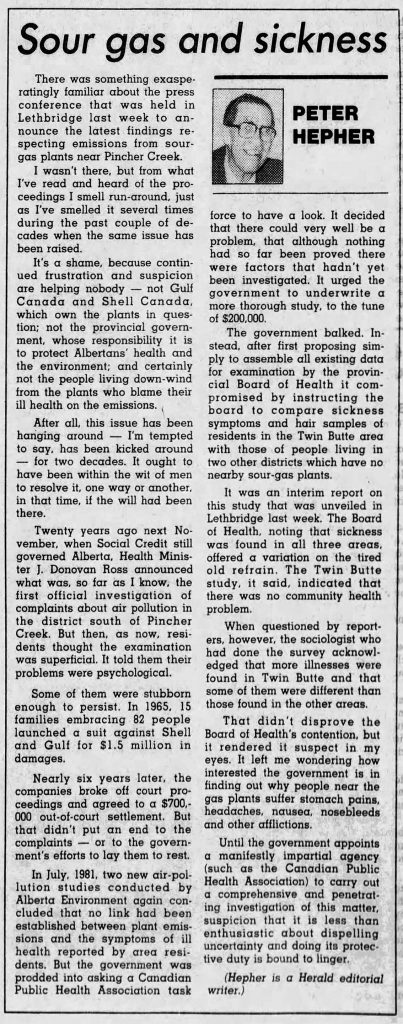
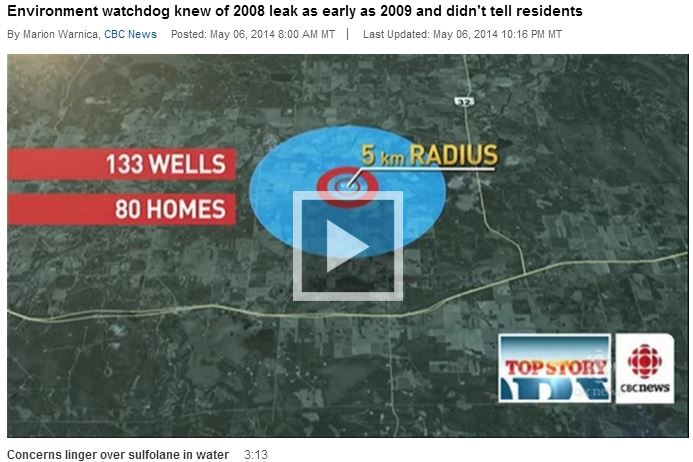
2009: CBC News reports Alberta’s water regulator knew 133 water wells and 80 homes had been harmed by known sulfolane contamination by the oil and gas industry, but didn’t tell the poisoned.
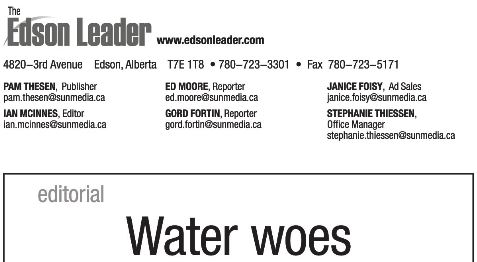
2014: Alberta Liberals speak on Sulfolane-contaminated drinking water wells in South Rosevear
…
Bonavista’s own experts found that during the previous ownership, a toxic chemical used in treating sour gas had leached into the soil. That contaminated well water and caused a dramatic loss in milk production as well as health problems in people and cattle.
…
2019: Non-Disclosure Agreements “are, indeed, an ugly instrument.”
***
2024: Sask. greenlights deal with Alberta, Manitoba to manage underground water reserves on Prairies, Deal comes as Sask.’s Lake Diefenbaker irrigation expansion moves ahead amid persistent drought by Moira Wyton, CBC News, Apr 12, 2024
![]() Not a word mentioned about the many aquifers already contaminated by the oil and gas industry in Alberta, BC, SK, MB (many with methane, ethane, BTEX, other life threatening contaminants, and of course, sulfolane – lots of sour gas in the dried up west, including in SK), or that frac’ing intentionally contaminates valuable water with toxic chemicals, and removes most of what is injected permanently removed from the hydrogeological cycle. And why no mention of putting solar panels over irrigation canals and other water infrastructure? Pathetic.
Not a word mentioned about the many aquifers already contaminated by the oil and gas industry in Alberta, BC, SK, MB (many with methane, ethane, BTEX, other life threatening contaminants, and of course, sulfolane – lots of sour gas in the dried up west, including in SK), or that frac’ing intentionally contaminates valuable water with toxic chemicals, and removes most of what is injected permanently removed from the hydrogeological cycle. And why no mention of putting solar panels over irrigation canals and other water infrastructure? Pathetic.![]()
Saskatchewan’s provincial government has greenlit expanding a key water deal to include cross-border groundwater reserves, aiming to ensure they are managed and shared sustainably amid growing threats posed by drought, pollution and climate change.
The proposed changes to the Master Agreement on Apportionment between Saskatchewan, Alberta, Manitoba and the federal government would empower the Prairie Provinces Water Board to assess, monitor and — if needed — take action to manage transboundary aquifers.
The Prairie Provinces Water Board, formed by the governments of the three Prairie provinces and the federal government in 1948, is responsible for the administration of the 1969 agreement, and provides a forum to resolve water issues between jurisdictions.
The changes to the agreement incorporate risk-management principles to the “collaborative” approach the provinces have taken to sharing surface water under the agreement since it was signed in 1969, according to the Saskatchewan Water Security Agency.
“WSA believes this amendment builds upon the strong, collaborative relationships of the PPWB members to continue to ensure Saskatchewan’s water resources are sustainable, adaptable, and reliable,” said Sean Osmar, the Saskatchewan agency’s communications manager, in a statement emailed to CBC last week.
The change comes on the heels of plans in both Alberta and Saskatchewan to ramp up irrigation, as persistent drought damages crop yields and challenges the ability of farmers and ranchers to put food on their own tables.
Last month, Premier Scott Moe said Saskatchewan has begun design work and consultations as it’s set to begin construction on the first phase of the Lake Diefenbaker expansion project next year.
Lake Diefenbaker was created in 1967 by the provincial and federal governments to supply water for a range of purposes, including irrigation.
Orders in council show that Saskatchewan Minister of Agriculture David Marit authorized the province’s water agency to agree to the amendments to the interprovincial water agreement on March 28.
The federal government has also agreed to the proposed expansion of the deal, according to an order in council.
The Saskatchewan Party government, like the governments of Alberta and Manitoba, supports including groundwater resources as part of the agreement, said a Thursday statement from Marit, who is also minister responsible for the water agency.
The amendment to the agreement is “a proactive approach taken by the board to include groundwater resources,” Marit’s statement said.
‘Lesser-known’ part of water systems
Aquifers are underground geologic formations made of layers of gravel, rocks and silt that can hold and store water that percolates down from rainfall and other sources on the surface. The water can then be accessed via a well, some of it already fit to drink.
These deposits vary in composition, thickness and depth but can span thousands of kilometres and cross one or more provincial boundaries, according to the proposed agreement.
Groundwater provides about one-quarter of residential water used in the Prairies and upwards of 90 per cent for residents in rural areas, plus “significant” portions of irrigation water for agriculture and livestock, according to a 2000 report from the Prairie Provinces Water Board.
The addition of transboundary aquifers to the agreement is a welcome one, says Patrick Cherneski, executive director of the PPWB.
Population growth and increased development is driving demand for well water both for drinking and irrigation, he said, but the water board doesn’t currently have the power to help co-ordinate how the provinces should share or manage the supply.
“Groundwater is kind of the lesser-known, out-of-sight aspect of our water cycle,” Cherneski said in an interview last week.
When people think of water, they generally think of surface water, but groundwater “is an important aspect because increasingly rural and urban residents are drawing upon it,” he said.
Cherneski says that while the quality and supply of both groundwater and surface-level water in one jurisdiction can be influenced by activities in another, the stakes are often higher for groundwater management.
- Sask. researcher says provincially-encouraged oil, gas extraction method could put groundwater at risk
- ‘An abomination’: Sask. water expert warns of contamination following Alberta’s coal policy changes
It’s much harder to clean up an aquifer because they are isolated and their water much slower-moving than rivers and streams at surface level, he said.
“If there are any pollutants that get into an aquifer, first of all it’s very difficult to get at, but it also takes a long time for that to move through the system,” said Cherneski.
“It often can take decades or sometimes centuries for the water to flow.”
He estimates there are as many as 30 major aquifers that his organization will identify and assess once the revised agreement enters into force.
Saskatchewan’s water agency says provinces and the federal government are ready to move forward with implementation of the agreement once it is signed “to achieve sustainable and equitable sharing of water resources.”
Cherneski says he expects it to be signed in the coming months.
